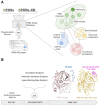PDBe aggregated API: programmatic access to an integrative knowledge graph of molecular structure data
- PMID: 34081107
- PMCID: PMC8570819
- DOI: 10.1093/bioinformatics/btab424
PDBe aggregated API: programmatic access to an integrative knowledge graph of molecular structure data
Abstract
Summary: The PDBe aggregated API is an open-access and open-source RESTful API that provides programmatic access to a wealth of macromolecular structural data and their functional and biophysical annotations through 80+ API endpoints. The API is powered by the PDBe graph database (https://pdbe.org/graph-schema), an open-access integrative knowledge graph that can be used as a discovery tool to answer complex biological questions.
Availability and implementation: The PDBe aggregated API provides up-to-date access to the PDBe graph database, which has weekly releases with the latest data from the Protein Data Bank, integrated with updated annotations from UniProt, Pfam, CATH, SCOP and the PDBe-KB partner resources. The complete list of all the available API endpoints and their descriptions are available at https://pdbe.org/graph-api. The source code of the Python 3.6+ API application is publicly available at https://gitlab.ebi.ac.uk/pdbe-kb/services/pdbe-graph-api.
Supplementary information: Supplementary data are available at Bioinformatics online.
© The Author(s) 2021. Published by Oxford University Press.
Figures

References
-
- Berman H. et al. (2003) Announcing the worldwide Protein Data Bank. Nat. Struct. Biol., 10, 980. - PubMed

